Cadence is all about how music resolves, breathes, and moves forward.
It can shape the emotional journey of a track through one of my favorite topics: tension and release.
Plus, it has the ability to completely transform the mood of a song by creating a sense of closure or leaving things unresolved (dealer’s choice).
So, as producers and songwriters, it’s important to know all about what is cadence in music so you can craft more impactful transitions and evoke specific emotions.
That’s why we’re breaking down everything to help you answer the question, “what is cadence in music,” like:
- Understanding the basics of cadences ✓
- Different types of cadences (perfect authentic cadences, plagal cadences, half cadences, etc.) ✓
- How to use cadences in songwriting ✓
- Cadences in beat drops and transitions ✓
- Experimenting with non-diatonic cadences ✓
- Building strong progressions with cadences ✓
- Techniques for each cadence type ✓
- Advanced cadence techniques for modulation ✓
- Combining cadence types for unique effects ✓
- Common mistakes when using cadences
- Much more ✓
After this article, you’ll know everything about cadence in music so your tracks will always feel dynamic and emotionally charged.
Plus, you’ll be able to create smoother transitions, create epic musical phrases, and elevate your tracks/skills like an expert.
Remember, successfully mastering cadence can seriously elevate your compositions 一 making your music more memorable and impactful.
Whether you’re creating pop hits, cinematic scores, or experimental tracks, understanding cadences can be a game-changer.
So, let’s dive in…
Table of Contents
What is Cadence in Music? Breaking it Down
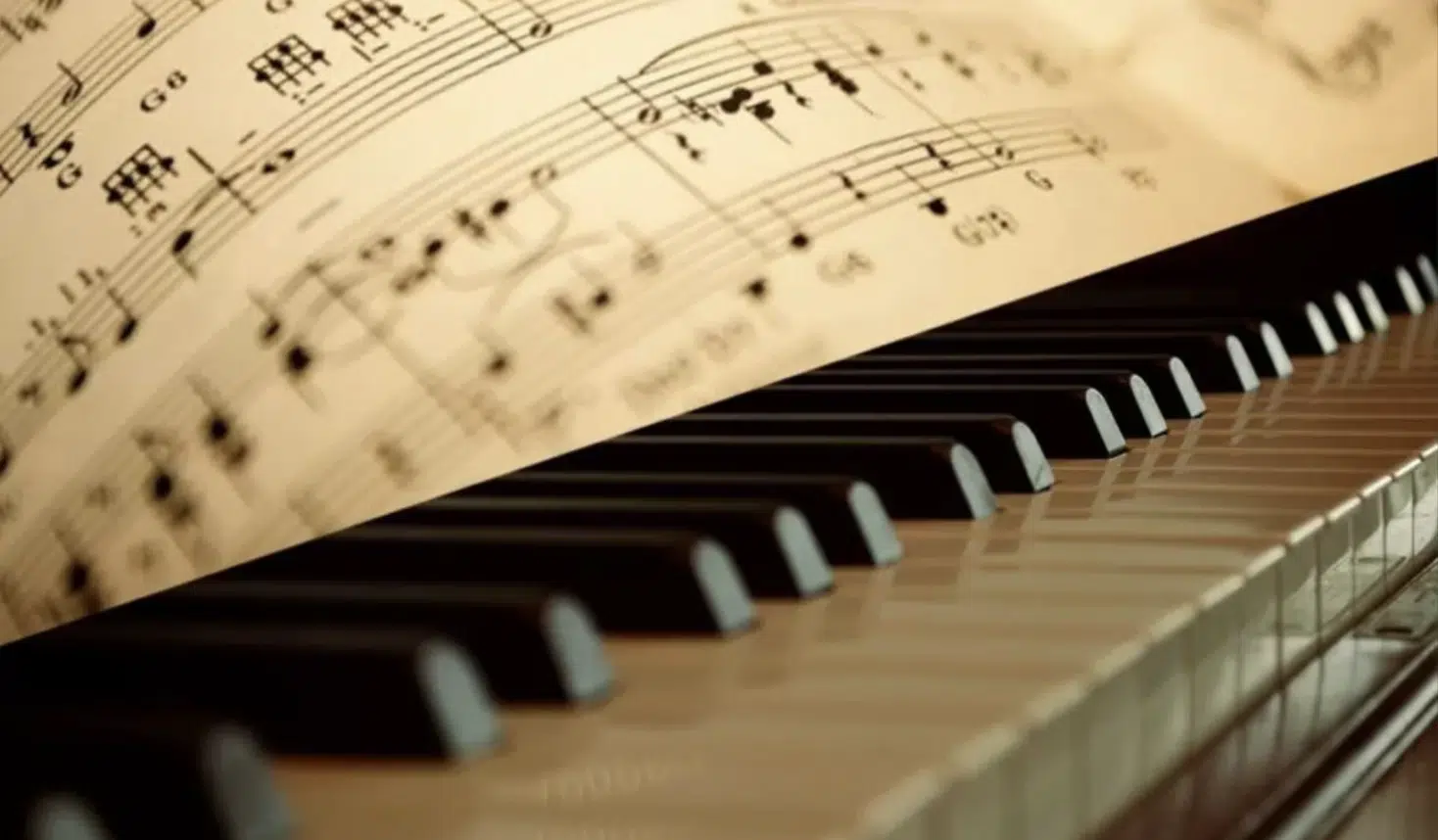
When talking about music theory, one term that comes up often is “cadence.”
So, what is cadence in music?… Well, in the simplest terms, a cadence is a sequence of chords that brings a phrase, section, or piece of music to a close.
It’s like the punctuation in a musical sentence, helping the listener feel the end of a phrase or a musical idea.
For any music producer or artist, understanding different cadence types is essential to creating tension, providing resolution, and adding emotional impact to tracks.
Now that you have a basic understanding of what is cadence in music, let’s break down the different types of cadences in detail.
Different Types of Cadences
There are many different types of cadences, each with its unique effect. Let’s kick things off by diving into them so you can understand how exactly they can shape the structure and feel of your music.
-
Imperfect Authentic Cadence
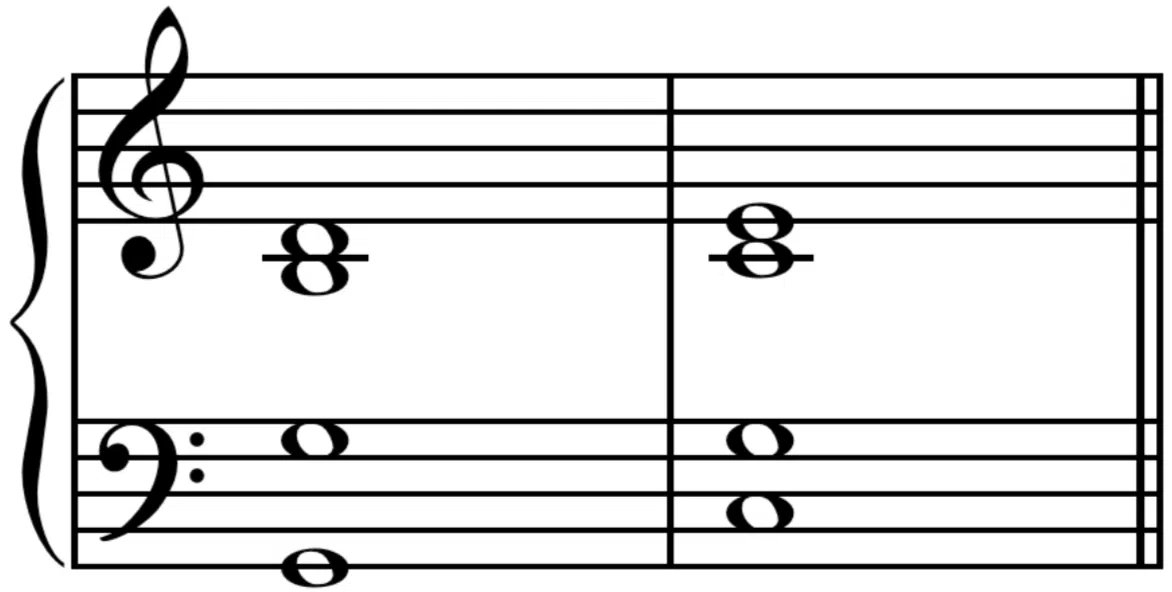
Imperfect Authentic Cadence in C
An imperfect authentic cadence involves moving from a dominant chord to a tonic chord, but with some variation that makes it less “perfect.”
Unlike the perfect authentic cadence, where the V chord (dominant) leads to the I chord (tonic) with both in root position and the tonic note in the highest voice, the imperfect cadence version lacks this sense of finality.
This could be because the chords aren’t in root position or the final tonic chord doesn’t have the tonic note as the highest note.
Imperfect authentic cadences are used when a sense of resolution is needed but not complete closure, if that makes sense.
In pop music, for example, an imperfect authentic cadence might provide a softer landing at the end of a verse before launching into a more resolved chorus.
The imperfect cadence works great for creating an emotional effect without sounding too finished 一 drawing people in.
This type of cadence can be very useful when you want to keep the listener hanging on, waiting for the next phrase to resolve.
As a music producer, knowing how to use an imperfect authentic cadence allows for creating smoother transitions in your tracks.
-
Perfect Authentic Cadence
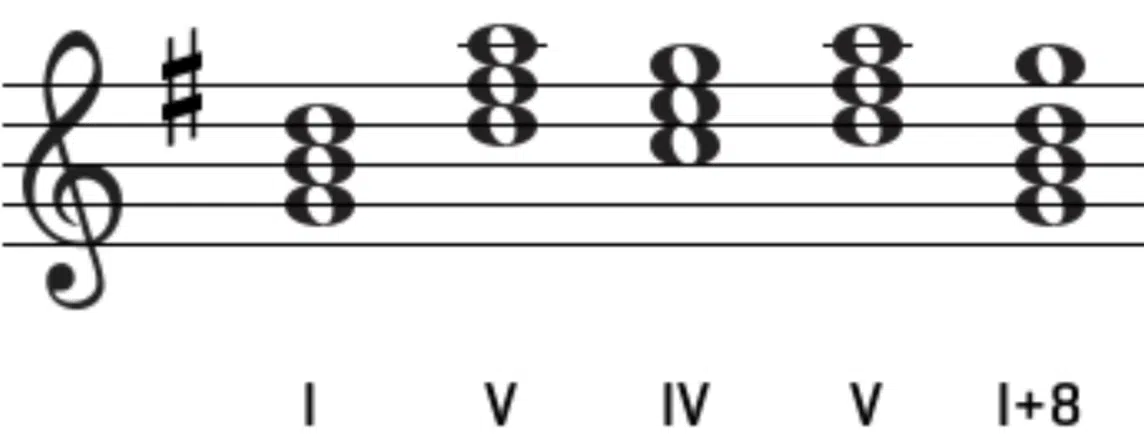
Perfect Authentic Cadence in G Major
A perfect authentic cadence is the most conclusive type of cadence because it provides a strong sense of closure to a musical phrase.
This cadence occurs when a V chord (dominant chord) resolves to a I chord (tonic chord), both of which must be in root position.
Keep in mind that, to qualify as a perfect authentic cadence, the tonic note must be the highest note in the final chord.
This creates a super powerful resolution that leaves no ambiguity, which is why the perfect authentic cadence is often used at the end of a section or entire piece.
In classical music, a perfect authentic cadence typically appears at the conclusion of a movement, bringing a clear and decisive end.
In more modern, popular music, it might be used to end a chorus or a bridge 一 giving listeners that strong feeling of the perfect ending.
The strength of the perfect authentic cadence lies in its ability to provide a satisfying conclusion so the listener really feels the music has reached its final destination.
That sounded a little ‘end-of-life-y’ but you get what I’m saying.
Mastering the use of a perfect authentic cadence can help deliver a final punch to a track for the full impact.
-
Plagal Cadence
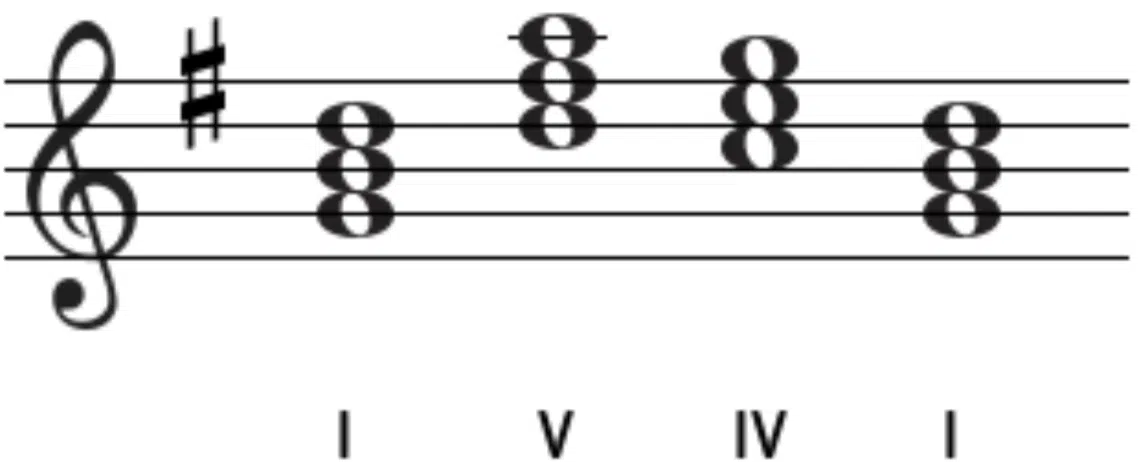
G Major Plagal Cadence
The plagal cadence, aka the “Amen cadence,” moves from the IV chord (subdominant chord) to the I chord (tonic chord).
This cadence is frequently used in church music, particularly at the end of hymns, hence its nickname.
Unlike the authentic cadence, the plagal cadence has a softer, more reflective feel.
It doesn’t provide the same strong sense of resolution but offers a smoother and more calming closure to a phrase, so it’s still important.
In pop music and other genres, a plagal cadence can provide an introspective ending to a section or even an entire track.
It’s not as commanding as an authentic cadence, but sometimes, that’s exactly what a song needs (it all depends on the vibe you’re going for).
You can use the plagal cadence to give a soothing effect after an intense chorus or bridge 一 leading back into the verse.
-
Half Cadence
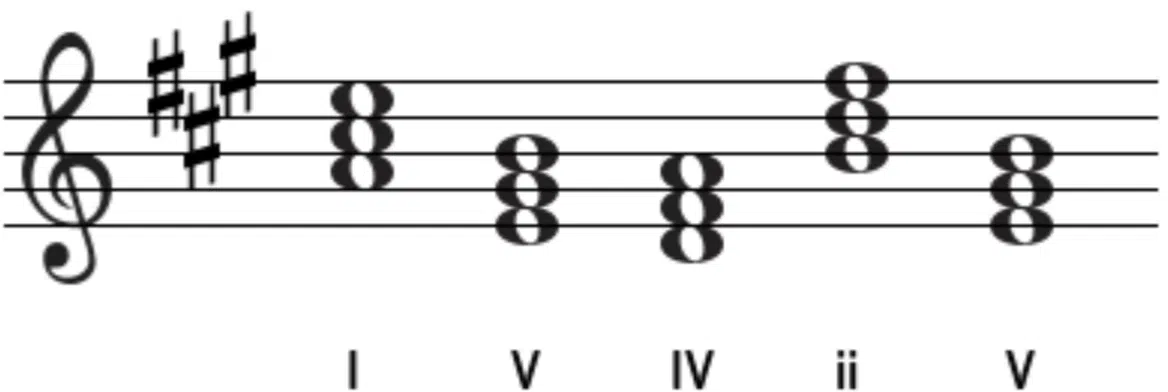
A Major Half Cadence
A half cadence is a type of cadence that ends on the dominant chord (V) to create an intriguing feeling of suspense or anticipation.
Unlike a finished cadence (which brings a phrase to a close) a half cadence leaves the listener hanging, waiting for more.
This unresolved feeling makes half cadences perfect for setting up tension, especially at the end of a phrase that is leading into a huge climax.
In pop and rock music, for instance, a half cadence can be used to transition smoothly into a powerful chorus or bridge.
A half cadence is often used in the middle of a phrase to keep the momentum going because it’s whole thing is to propel the song forward, keeping the audience engaged.
Using a half-cadence in music production helps create energy that drives the track onward 一 encouraging the listener to stay tuned for the resolution.
-
Deceptive Cadence
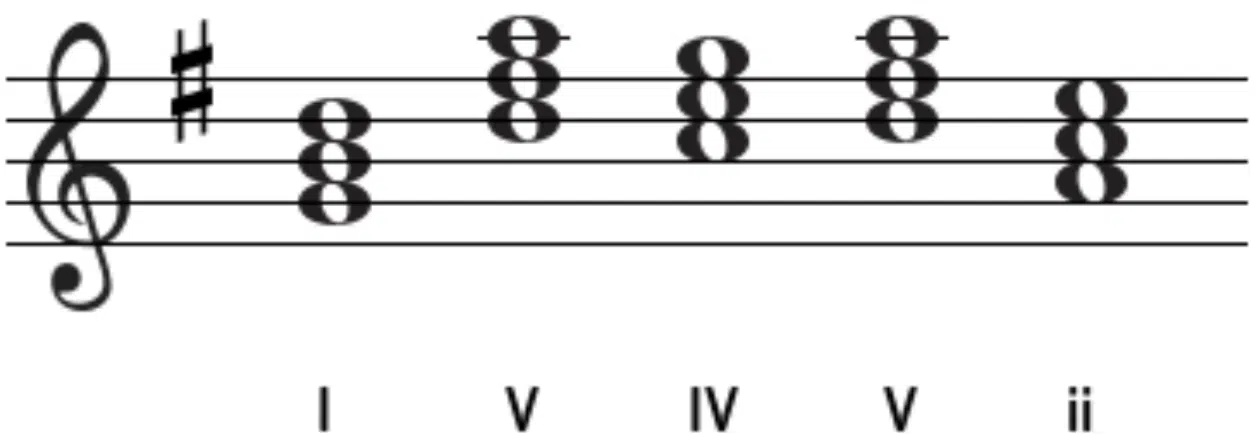
G Major Deceptive Cadence
A deceptive cadence is all about surprising the listener, which is why it got that ominous nickname that I absolutely love.
Instead of resolving to the expected tonic chord, a deceptive cadence moves from the V chord (dominant chord) to an unexpected chord, often the vi chord in a major key.
This creates a sudden shift in harmony, providing a twist in the harmonic progression.
Many deceptive cadences are used to prolong/draw out a phrase or to add drama to keep the listener guessing about what will happen next.
In many pop songs, a deceptive cadence can lead into a bridge or another section that gives a fresh perspective on the song’s theme.
The use of deceptive cadences progressing to a minor chord rather than a major chord can create a powerful emotional moment that people love.
With them, you can add depth and complexity to your chord progressions to really have a professional edge and get your listeners hooked.
Bottom line, using a deceptive cadence effectively can make a track feel more dynamic and less predictable.
-
Phrygian Cadence
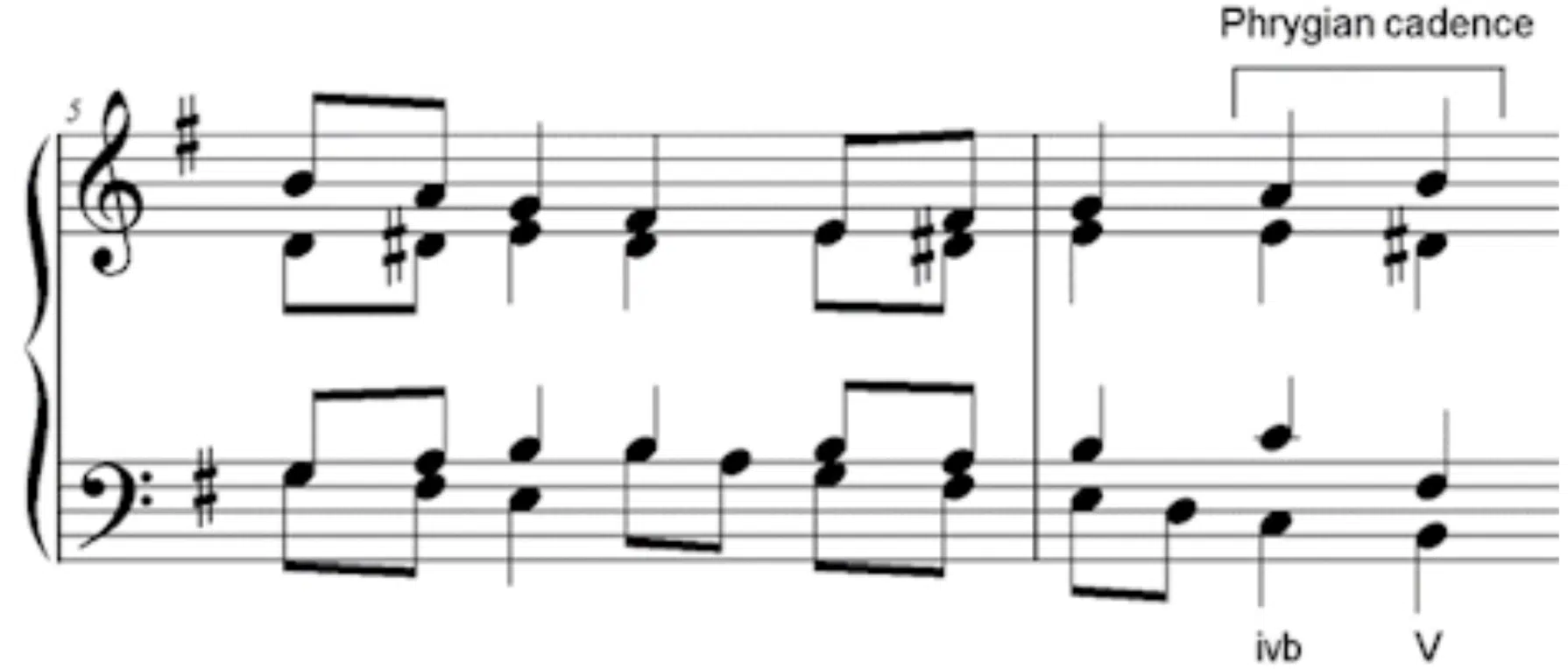
A Phrygian cadence is most commonly found in minor keys and creates a unique sense of unmatched tension.
It moves from a iv6 chord (a subdominant chord in first inversion) to a V chord, creating a half-step movement in the bass note, which is quite distinctive.
This cadence has a medieval or ancient feel and is used in genres that want to evoke those types of moods, mostly classical music or even some metal genres.
The Phrygian cadence can be a great way to create a track that you want to feel dark, haunting, and unresolved.
The movement of the bass note is key to achieving the Phrygian sound, and it’s often used in pieces where you want the harmonic progression to feel extra dramatic.
When used in the right context, this cadence can add a unique flavor to your track, giving it a different edge than the more common cadences.
-
Pro Tip: Harmonic Cadence

When you hear the term ‘harmonic cadence,’ just know that it refers to any progression of two chords that signals the end of a musical phrase.
It’s a broad term that encompasses several cadence types, from the perfect authentic to the deceptive that we talked about.
When a harmonic cadence occurs, it creates a sense of resolution or pause, giving shape and meaning to a musical phrase.
In a way, understanding harmonic cadences means understanding the fundamental building blocks of how music communicates emotion and structure.
Different harmonic cadences, like the imperfect cadence or the perfect cadence, provide various levels of closure 一 some feel conclusive, while others don’t.
Mastering the use of harmonic cadences in all their epic forms is key for any music producer like yourself looking to shape the flow/feel of a track.
It helps in structuring the harmonic progression to build tension and release; when the listener hears it, they’ll be super invested.
-
How Cadence Can Improve Your Tracks
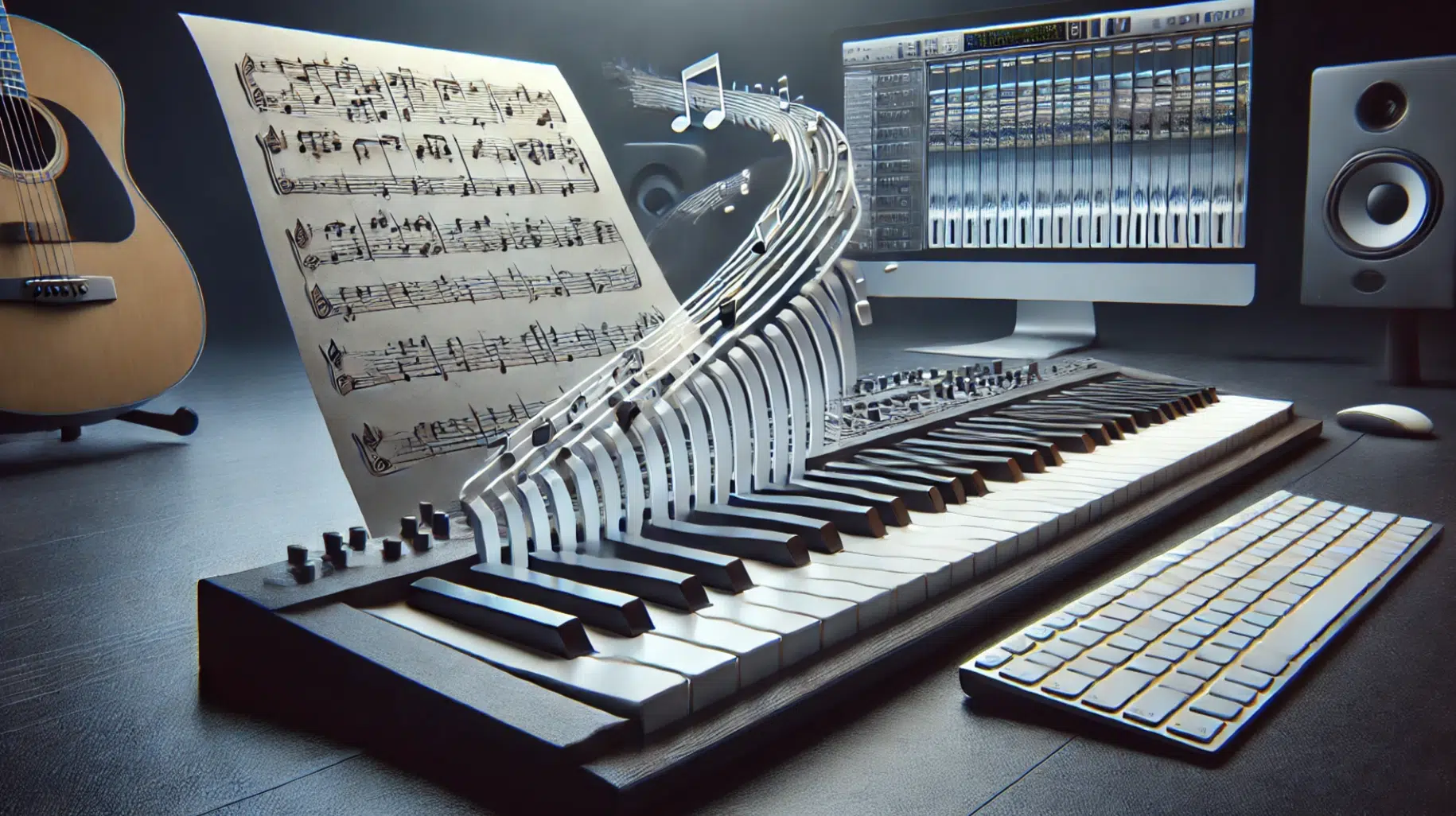
Knowing what is cadence in music can greatly enhance how a track feels and flows, especially when trying to create a more dynamic listening experience.
For example, using a perfect authentic cadence at the end of a chorus can give it a powerful sense of closure and make the transition back to a verse feel more impactful.
On the flip side, a deceptive cadence can trick the listener by resolving to an unexpected chord 一 creating a sense of surprise and prolonging the tension.
This is perfect for breakdowns or bridges, where you want to keep listeners on edge before delivering a drop or a key change.
Remember, it’s all about reeling people in and blowing their minds.
By combining a half cadence with a sudden tempo shift, you can create a moment that feels both dramatic and unresolved, perfect for leading into a climactic section.
Also, using a plagal cadence (Amen cadence) can provide a softer resolution, ideal for ending a mellow verse or calming outro.
Understanding what is cadence in music will help you control these emotional highs and lows so each section of a track leaves a lasting impact after the song ends.
Techniques for Producers & Artists
Understanding what is cadence in music is not just about music theory; it’s about actually applying that knowledge to make your tracks stand out. Next, let’s cover some ways to use cadences in your music to elevate your production game.
-
Using Cadences in Songwriting

When writing songs, understanding what is cadence in music gives you the power to shape the entire emotional vibe.
For example, if you’re writing a pop ballad and want to make a verse feel unresolved, you might use an imperfect authentic cadence, where the dominant chord resolves to the tonic but isn’t in root position or lacks the tonic in the melody.
This slight sense of incompletion keeps listeners hooked.
Conversely, you might use a perfect authentic cadence to bring a strong, conclusive end to a chorus, reinforcing the main hook and making it unforgettable.
If you want to create a reflective moment in a bridge or outro, the plagal cadence can provide a softer resolution 一 making it perfect for emotionally charged lyrics.
Also, throwing in a deceptive cadence (again, where the dominant chord leads to a minor chord instead of the expected tonic) can create an unexpected twist.
It’s perfect for really throwing in some shock factor, which people absolutely love.
Experimenting with these cadences can make your songwriting more versatile and your music more memorable, so don’t slack in that department.
-
Cadences in Beat Drops and Transitions

For electronic music producers and beatmakers, knowing what is cadence in music is key for creating effective beat drops and transitions.
One technique is to use a half cadence right before a drop.
This ends the phrase on the dominant chord, creating unresolved tension that builds anticipation for the drop, of course.
Picture a build-up in a future bass track where the tension grows, but instead of resolving to the tonic, it lands on the V chord and pauses…
This can make the following drop hit harder and feel more complete.
Using a deceptive cadence before a breakdown can also lead the listener away from the expected tonic chord and into a different harmonic space, adding a unique twist.
For transitions, an Amen cadence can be used to calm things down 一 providing a natural and softer transition from a heavy beat drop back to a more melodic closure verse or outro.
By creatively applying these cadence types, you can manipulate the energy and flow of a track, keeping your listeners addicted from start to finish.
-
Experimenting with Non-Diatonic Cadences
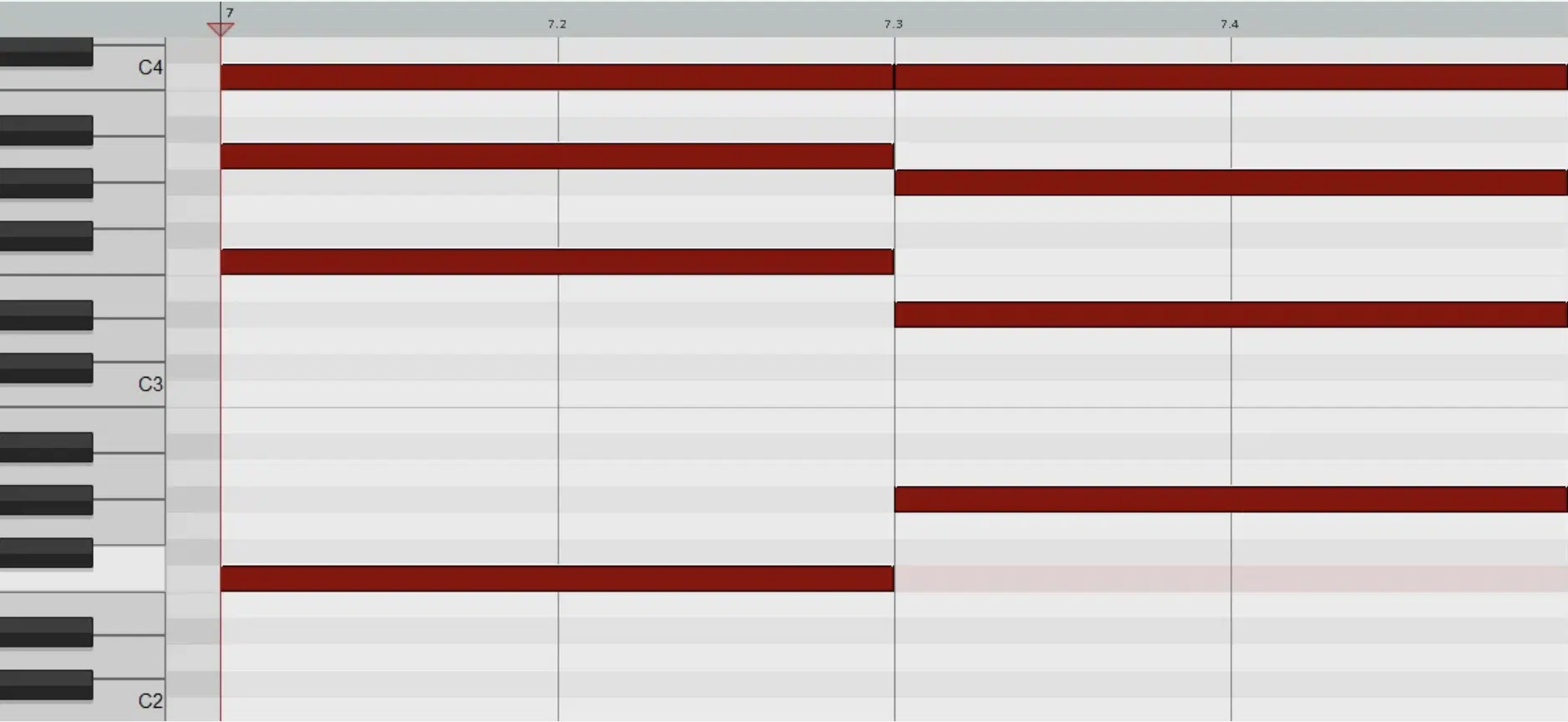
When understanding what is cadence in music, it’s important to think outside the box and explore non-diatonic cadences.
Unlike traditional cadences that stick within a key, non-diatonic cadences use chords that aren’t naturally found in the key, creating unexpected shifts.
For example, moving from a V chord to a bVI chord instead of the expected I chord can produce a unique, show-stopping emotional effect.
NOTE: This is very effective when it comes to genres like indie pop or cinematic music, where surprises in tonic harmony can add depth.
Try using a deceptive cadence that ends up on a borrowed chord from the parallel minor scale (like resolving V to iv in a major key).
This can add a darker, more introspective twist to a section, perfect for a breakdown or bridge that contrasts with the rest of the track.
Understanding what is cadence in music and experimenting with non-diatonic cadences can open up new creative possibilities, making your tracks more unpredictable.
And, as you know, based on the attention span of people today, shaking things up and making your tracks more unpredictable is always a good thing.
-
Building Strong Chord Progressions with Cadences
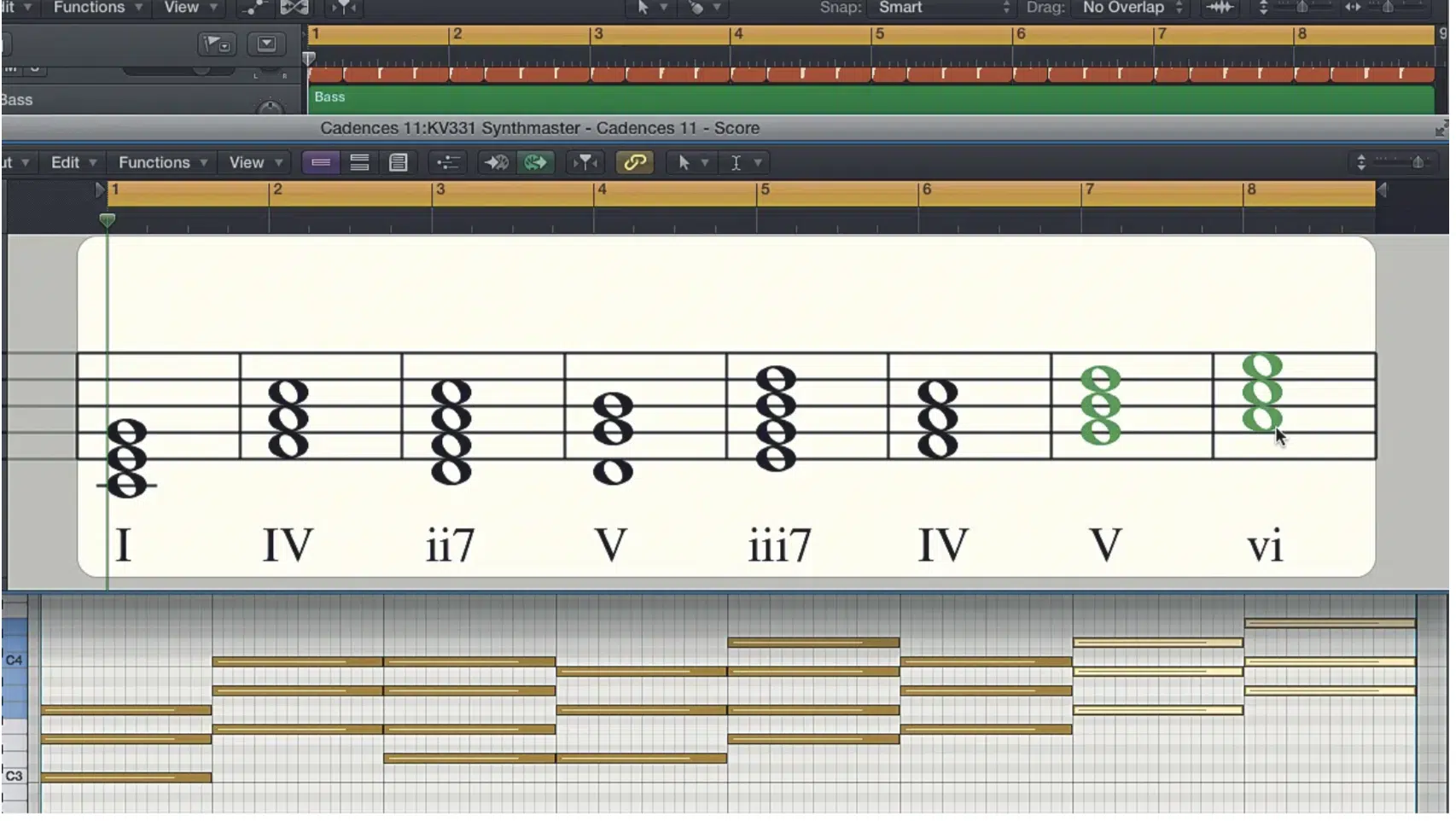
Chord Progression With Deceptive Cadence
Building strong chord progressions is at the core of professional music production, and knowing what is cadence in music is key to this.
This is because cadences can help define the end of phrases to create natural points of rest or tension in your progressions.
For example, using a series of imperfect authentic cadences within a verse can keep the harmonic progression moving forward.
It builds anticipation for a perfect authentic cadence in the chorus, giving your chorus a powerful, more grounded feel that makes it shine.
You could also use a plagal cadence at the end of a chord progression to give it a softer, gospel-like feel, which works well in R&B and soul genres.
Pro Tip
Another great technique is to combine half cadences and finished cadences in a progression to create a push-and-pull dynamic, where tension builds and releases.
Mastering what is cadence in music allows you to throw together progressions that keep listeners engaged/emotionally connected throughout your tracks.
Advanced Cadence Techniques
For those of you looking to push your music beyond standard harmonic conventions, the following advanced techniques are awesome. So, let’s explore some ways to use cadences to modulate keys and combine different cadence types for unique effects.
-
Modulating Between Keys Using Cadences

One advanced way to help you understand what is cadence in music, it involves using cadences to modulate between keys like a boss.
For example, you can use a half cadence on the V chord of the new key to prepare the listener for a modulation.
This works well when transitioning from a verse in the key of C major to a chorus in G major because, by ending the verse on a G7 (V7 of the new key), the ear naturally moves into the new tonic.
On the flip side, a deceptive cadence can be used to modulate by resolving the V chord to a minor chord in a different key.
For instance, resolving from D major (V in G major) to E minor (iii in C major) can smoothly shift the tonality.
Understanding how to use cadence types to modulate between keys allows you to create a more dynamic and evolving music composition.
It will enhance the overall journey of a track and make things more immersive.
-
Creative Cadence Variations in Music Production
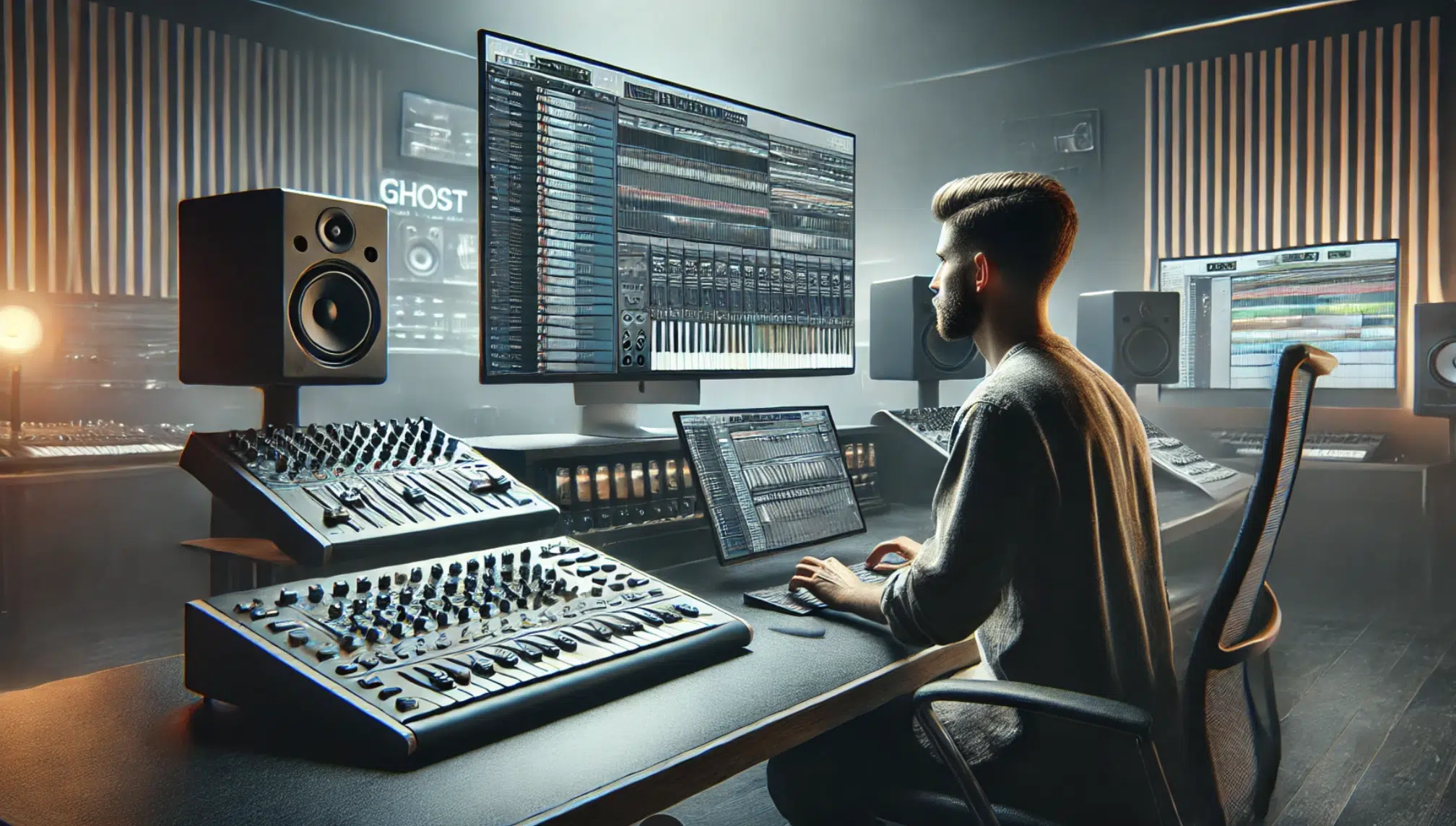
Understanding what is cadence in music is just the beginning 一 applying creative variations is where the real magic can happen.
For instance, instead of using a standard perfect authentic cadence at the end of a section, you might add a passing tone or a suspended fourth before ending.
This can create a more modern and unexpected resolution.
Another creative variation is the use of a Picardy cadence, where a piece in a minor key ends with a major chord for a surprisingly uplifting conclusion.
This technique works great in electronic music when you want a track to end on a high note after a darker, more intense buildup.
You could also try layering a Landini cadence (where the leading tone descends to the sixth scale degree before resolving to the tonic) over a syncopated rhythm.
It will add both harmonic and rhythmic cadence interest.
By experimenting with these creative cadence variations, you can find new ways to answer the question of what is cadence in music with unique and innovative harmonic progressions.
-
Cadence and Melody: How They Interact
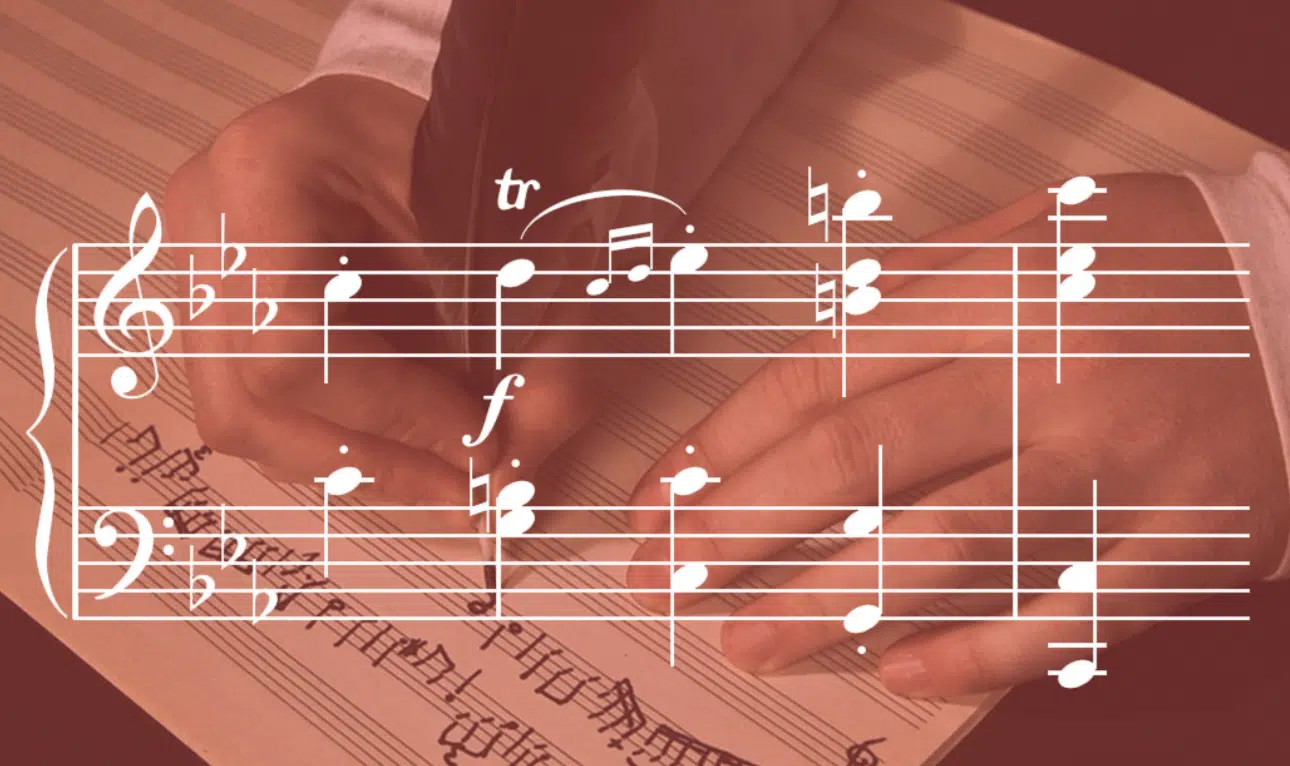
Understanding what is cadence in music also involves recognizing how it interacts with melody.
Cadences typically are not just about harmonic closure; they also guide the melodic movement and its resolution.
For example, if you’re working with a perfect cadence, aligning the melody’s highest note with the tonic chord creates a powerful sense of finality.
In contrast, an imperfect authentic cadence can be used to leave a melody unresolved, creating a sense of longing or expectation like we talked about.
Whenever you want your vocal lines to tell an emotional story that doesn’t neatly resolve, it’s perfect.
When writing a melody over a half cadence, consider having it peak on a note that’s part of the dominant chord, which creates tension and compels the listener to want more.
A deceptive cadence can lead a melody away from the expected tonic resolution 一 adding an element of surprise that can be powerful in pop and alternative tracks.
Integrating cadence and melody effectively can give you more tools to define what is cadence in music and make your tracks unforgettable.
-
Experimenting with Unconventional Cadences
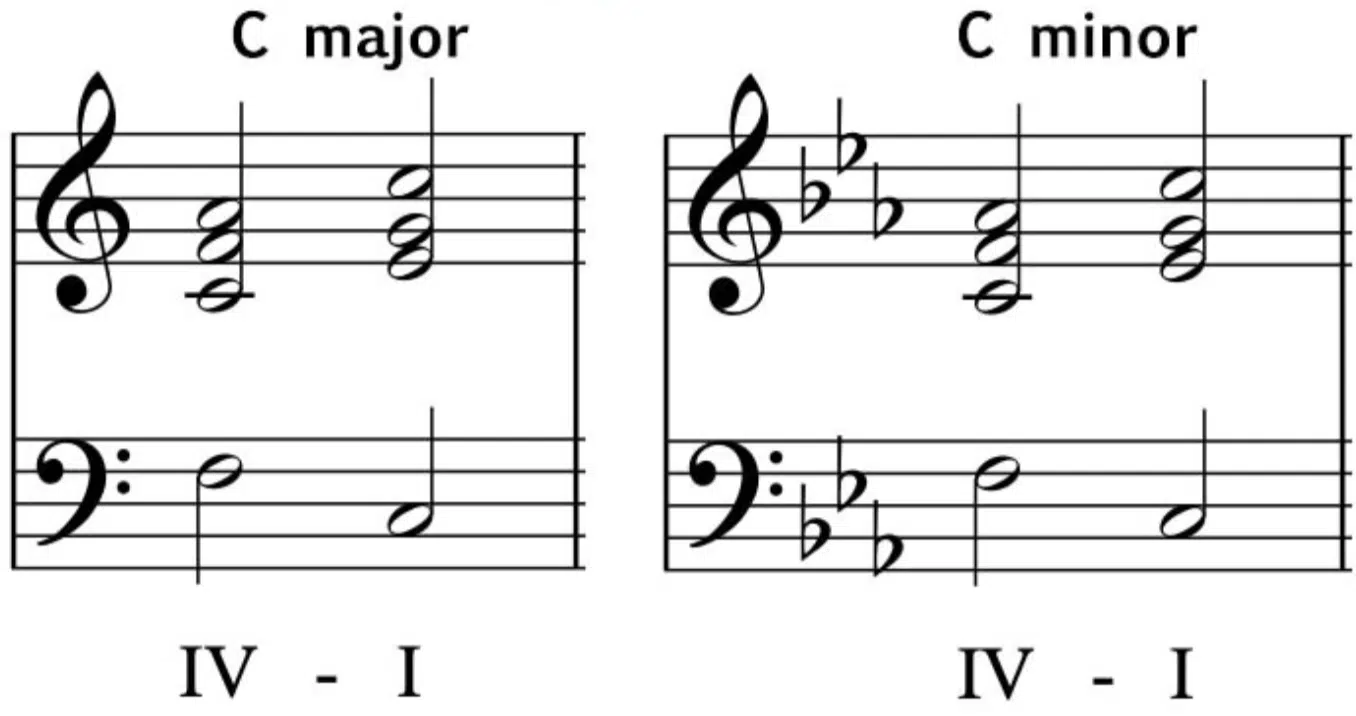
Major & Minor Plagal Cadences
Really knowing what is cadence in music means being willing to break the rules and try unconventional cadences (as is such with all parts of music production).
Consider using a minor plagal cadence, moving from iv to I, to add a darker, unexpected twist to a song that has primarily been in a major chord key.
This works well in genres like alternative rock or indie pop, where mood shifts can add depth that people really react well to.
You can also try an interrupted cadence, where instead of resolving to the tonic, the progression unexpectedly lands on a different chord, such as vi or iii.
This technique is super effective for creating surprise in ballads or cinematic scores.
Another technique is to use different cadences within the same phrase to create a complex harmonic journey…
For instance, starting with a Phrygian cadence and ending with a perfect cadence to blend tension and release in a single phrase.
Pushing the boundaries with these less conventional cadences can redefine what is cadence in music in your own style, making your tracks more innovative/engaging.
It might take a little while to really nail down all the different kinds and truly understand what is cadence in music, but once you do, you can really blow the competition away and cement yourself as a professional.
What is Cadence in Music: Final Thoughts
Cadence, as you now know, is super important when it comes to shaping the flow and emotion of your music.
It can help you create compelling transitions, build tension, and provide resolution so your tracks are always engaging and memorable.
Remember, it’s all about choosing the right cadences to match the mood, vibe, and narrative of your unique music.
But thankfully, by using the tips and techniques we talked about today, you’ll never struggle to create dynamic, emotionally resonant music again.
As a bonus, to further enhance your understanding of what is cadence in music and how to use it effectively, you’ve got to check out this Cinematic & Orchestral MIDI Chord Collection.
This invaluable collection includes over 1,800 MIDI files featuring expertly crafted cinematic and orchestral chords, progressions, and cadences.
It offers everything from standard major and minor chords to more complex ones like add9, add11, and sus2.
This way you can experiment with different cadence types and harmonic structures all day long (talk about efficiency).
Whether you want to create emotional orchestral scores or unique chord progressions in modern genres, this pack provides ready-to-use MIDI files to up your game.
You can bypass years of music theory study and instantly elevate your music with epic, evocative cadences that enhance the emotional depth of your tracks.
Now, it’s your turn to take what you’ve learned about what is cadence in music and put it into practice.
So, keep experimenting with different cadences and push the boundaries of your music to see how mastering cadences can elevate your production to a whole new level.
Until next time…







Leave a Reply
You must belogged in to post a comment.